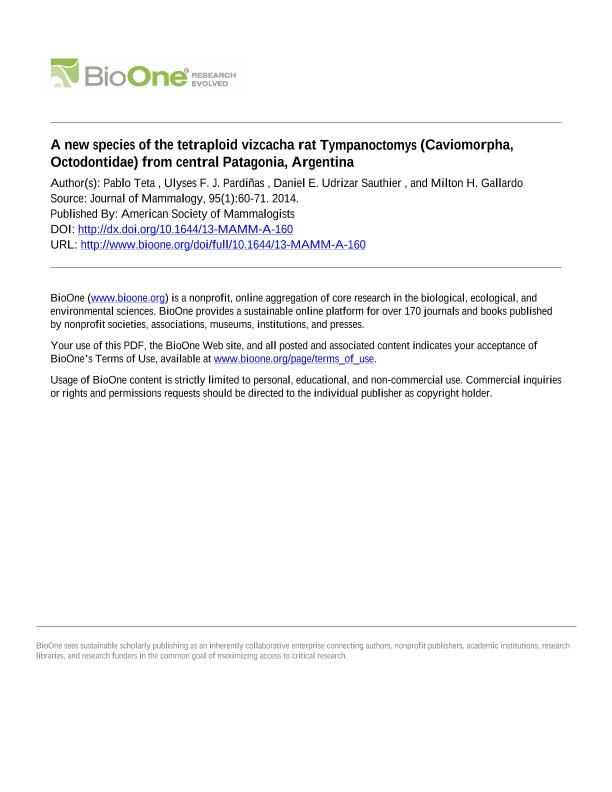Artículo
A new species of the tetraploid vizcacha rat Tympanoctomys (Caviomorpha, Octodontidae) from Central Patagonia, Argentina
Teta, Pablo Vicente ; Pardiñas, Ulises Francisco J.
; Pardiñas, Ulises Francisco J. ; Udrizar Sauthier, Daniel Edgardo
; Udrizar Sauthier, Daniel Edgardo ; Gallardo, Milton H.
; Gallardo, Milton H.
 ; Pardiñas, Ulises Francisco J.
; Pardiñas, Ulises Francisco J. ; Udrizar Sauthier, Daniel Edgardo
; Udrizar Sauthier, Daniel Edgardo ; Gallardo, Milton H.
; Gallardo, Milton H.
Fecha de publicación:
19/02/2014
Editorial:
American Society of Mammalogists
Revista:
Journal of Mammalogy
ISSN:
0022-2372
e-ISSN:
1545-1542
Idioma:
Inglés
Tipo de recurso:
Artículo publicado
Clasificación temática:
Resumen
A new living species of the desert-adapted tetraploid rodent Tympanoctomys (Caviomorpha, Octodontidae) is described. The new form is restricted to the type locality in Chubut Province, central Patagonia, Argentina, although is known from at least 4 additional Holocene-aged localities along the middle and lower valley of the Chubut River. Tympanoctomys sp. nov. is smaller than the living T. barrerae, its general coloration is yellowish (reddish in T. barrerae ) and its tail is equal to ~ 43–50% of head and body length (~49–53% in T. barrerae). Its skull and dentition are characterized by a unique combination of morphological traits, including narrow and posteriorly acuminate nasals (broad and barrel-shaped in T. barrerae ), supraoccipital not laterally expanded (expanded in T. barrerae), and 8-shaped lower 3rd molar (comma-shaped in T. barrerae and † T. cordubensis). Morphometric and genetic evidence supports the specific distinction of this Patagonian endemic Tympanoctomys, also characterized by smaller sperm than T. barrerae . The reduced range of the new species, coupled with its recent extinction from the Chubut River valley and the potential impact of large uranium mining projects in central Patagonia, suggest that this species faces a severe extinction risk in the short term.
Palabras clave:
Pipanacoctomys
,
Salinoctomys
,
Octodontids
,
Taxonomy
,
Chubut
Archivos asociados
Licencia
Identificadores
Colecciones
Articulos(CCT-CENPAT)
Articulos de CTRO.CIENTIFICO TECNOL.CONICET - CENPAT
Articulos de CTRO.CIENTIFICO TECNOL.CONICET - CENPAT
Citación
Teta, Pablo Vicente; Pardiñas, Ulises Francisco J.; Udrizar Sauthier, Daniel Edgardo; Gallardo, Milton H.; A new species of the tetraploid vizcacha rat Tympanoctomys (Caviomorpha, Octodontidae) from Central Patagonia, Argentina; American Society of Mammalogists; Journal of Mammalogy; 95; 1; 19-2-2014; 60-71
Compartir
Altmétricas



